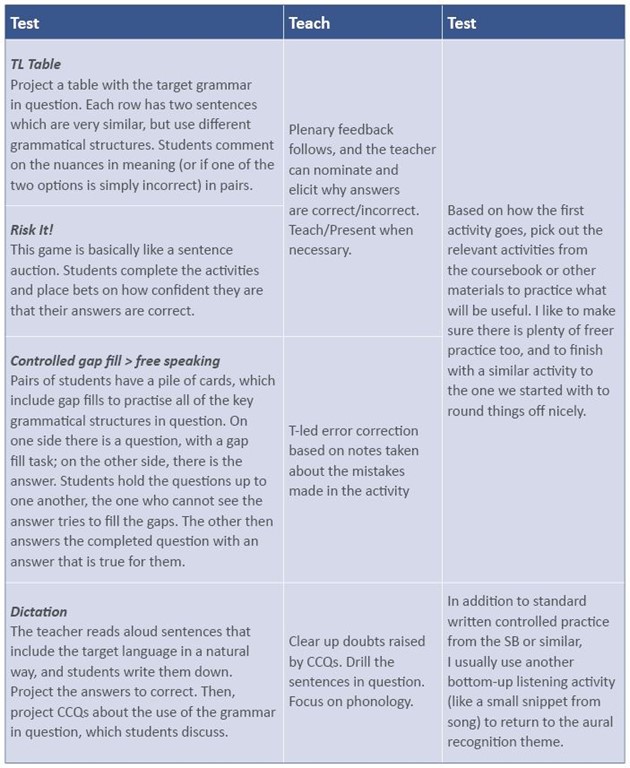Helping advanced learners avoid ‘the plateau’
Observations and ideas for teaching grammar beyond B2
By Luke Armstrong
As students move up the levels, there is a fundamental shift to take into account when it comes to grammar teaching, which is that the majority of what students see after B2 is, at least in theory, revision, and there are very few high-frequency grammatical structures left to learn.
This means that our students simply cannot make the giant leaps that they made at lower-levels: instead, progress comes from fine-tuning and taking smaller steps, such as learning chunks or lower-frequency grammatical structures.
I think the main challenges for the teacher at this level are firstly becoming better able to unearth fossilised errors; secondly, judging how to pitch the lesson to achieve ´i+1´ (providing input one ‘level’ above the learners’ current level); and, finally, how to avoid long presentation stages when there is so much grammar to cover. In this article, I will share some of the observations and ideas that have helped my teaching of higher-level groups evolve over the past decade.
Honing revision
My experience as an advanced learner of Spanish has informed my teaching, and I think the most satisfying moments I have had as a learner have been when teachers have helped me become aware of, and correct, my fossilised errors. In my opinion, a revision activity which helps unearth fossilised errors is one of the cornerstones of good advanced grammar lessons because it helps create a real sense of progress. Given that most advanced grammar lessons are predominantly revision, a logical starting point is establishing how well students know the grammar in question. I therefore think that the most effective framework for the vast majority of advanced grammar lessons is Test-Teach-Test, and not the more popular Presentation-Controlled Practice-Freer Practice model. It is immensely boring to have someone explain something that you already know, or to be made to practice something that you have already mastered, yet I expect most teachers, like me, have done this to far too many advanced learners over the years by following an inappropriate framework.
Our starting point should be the students, and giving them the chance to show what they know.
Although almost anything could work for the initial ´Test´ stage, here are some of my favourite task types. Needless to say, all of them require close monitoring from the teacher.

Shifting the focus
Another observation that has shaped my teaching is that I feel that we teachers have a tendency to overdo certain aspects of grammar lessons, such as the written form, meaning and controlled practice, and overlook others, like pronunciation and phonology, use and freer practice.
The written form and its spelling are often given a great deal more attention than aural recognition and pronunciation; ironically, I think most students are equally concerned, if not more so, by the latter, but we tend to focus on the former. In my experience, advanced students usually need much more help with aural recognition and pronunciation. Easy ways to add more of this into your teaching include doing more dictations, drilling, and focusing on phonology, especially weak forms. Remember that it is worth drawing students attention to the fact that English is a so-called stress-timed language, and most grammar words are unstressed, so an awareness of weak forms is particularly important for mastering grammar (e.g. ´It must have been …´ is normally pronounced ´ɪt məst əv bIn´ and not ´ɪt mʌst hæv biːn´). I think this helps students take a big step towards understanding others, and it helps avoid them sounding like robots too.
Secondly, ´meaning´ is usually the first port of call in a grammar presentation but ´meaning´ isn´t always helpful: ´use´ or ´function´ might be more understandable or relevant. For example, if a teacher tells a student that ´the passive is basically the same as the active, but the focus is more on the object, or the action´ then this is much harder to relate to than ´the passive is often used when the speaker wants to avoid responsibility for their actions´. This is particularly important given that this ´meaning´ might be the same in L1, but the ´use´ might not. For example, the passive exists in similar form in both in English and Spanish but the use is notably different.
Finally, students often get a lot of controlled practice in grammar lessons, and freer practice tends to be cut short or sacrificed when we run out of time in class. However, freer practice is extremely important too: as well as being generally more interesting than controlled practice, it really puts the focus on the student and gives them the space to make the language their own, and, maybe the space to make mistakes. In my experience, a lot of advanced students already have the grammar up their sleeves, but haven´t really got into the habit of using it when they could or should. I think freer practice is the key to getting them using it. I try to shift the weighting of my advanced grammar lessons to include more freer practice than controlled practice; with lower levels, I would say the opposite is true.
Spotting what is new
The last thing worth noting is that although much of teaching advanced is about revising, practising, fine tuning and spotting fossilised errors, there is still some new grammar that tends to appear at C1-C2. A few of the new areas are totally new structures (for example, inversion), but the majority are new chunks or lower-frequency structures for revisited grammar points (for example, conditionals usually pop up in advanced courses, but the conditionals that don´t follow the grammatical patterns of 0,1,2,3 and mixed 2/3 conditionals tend to be new for students at C1-C2 e.g. if + won´t, will - ¨If you won´t stop this, I´ll leave¨). One of the tricky balances for teachers of higher level classes to strike is working out how much to focus on these new lower-frequency elements because they are likely to lead to ´i+1´ and a sense of progress, and how much to focus on fine-tuning the higher-frequency elements which students are likely to hear, say and see much more often.
Knowing what grammatical structures are new at higher levels usually comes with experience, but a comparison of coursebooks from different levels is a good place to start. Unlike before B2, beyond B2 there is not such a clear consensus on which grammatical structures should be taught before others. I think it is important to know before you go into the classroom what you expect to be revision and what you think is probably new and will need presenting.
Final thought
I hope these reflections have given you some food for thought and help you keep your advanced learners motivated and progressing.
 |
Author's Bio: Luke has been working in TEFL since 2009, and is currently based at IH Lacunza San Sebastián (Spain). He is CELTA, Delta and IHCYTL qualified, and enjoys teaching a range of levels and ages, and also has an interest in teacher training. This article is a write-up of part of a training session that Luke gave in late 2018. |